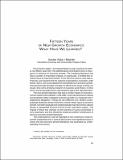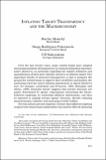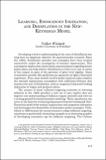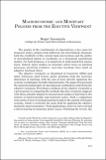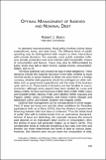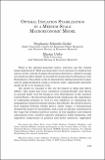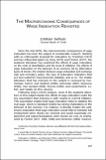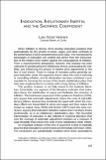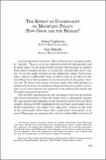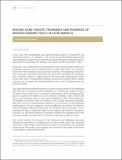Search
Now showing items 31-40 of 40
Fifteen years of new growth economics: what have we learned?
Paul Romer’s paper, “Increasing Returns and Long-Run Growth,” is now fifteen years old. This pathbreaking contribution led to a resurgence in research on economic growth. The resulting literature has in had a number of important impacts. In particular, it shifted the research focus of macroeconomists. ...
Inflation target transparency and the macroeconomy
Over the last twenty years, many central banks have adopted increasing standards of transparency in communicating their monetary policy objectives, in particular regarding the explicit definition and quantification of their price stability objective or inflation target. One important benefit of increased ...
Learning, endogenous indexation, and disinflation in the new-keynesian model
Developing a better understanding of the costs of disinflation has long been an important objective for macroeconomic research. Since the 1980s, disinflation episodes and strategies have been studied extensively under the assumption of rational expectations. This assumption implies that central bank ...
Macroeconomic and monetary policies from the eductive viewpoint
The quality of the coordination of expectations, a key issue for monetary policy, obtains from different, but interrelated, channels: both the credibility of the central bank intervention and the ability of decentralized agents to coordinate on a dynamical equilibrium matter. For both purposes, it is ...
Optimal management of indexed and nominal debt
In standard macroeconomics, fiscal policy involves choices about expenditures, taxes, and debt issue. The different kinds of public spending may be distinguished with respect to their interactions with private decisions. For example, some public activities influence private production and some interact ...
Optimal inflation stabilization in a medium-scale macroeconomic model
What is the optimal monetary policy, and how can the central bank implement it? Both questions have been extensively studied, but always in the context of simple theoretical structures, which by design are limited in their ability to account for actual observed business cycle fluctuations. This article ...
The macroeconomic conseguences of wage indexation revisited
Since the mid-1970s, the macroeconomic consequences of wage indexation has been the subject of considerable research. Starting with an enthusiastic proposal for indexation by Friedman (1974) and two influential papers by Gray (1976) and Fischer (1977), the academic literature has examined the effects ...
Indexation, inflationary inertia, and the sacrifice coeficient
When inflation is chronic, firms develop indexation practices that automatically tie the growth of prices, wages, and other contracts to the performance of some comprehensive price index. The microeconomic advantages of indexation are evident and derive from the immunization of the relative price ...
The effect of uncertainty on monetary policy: how good are the brakes?
In most industrial countries, official interest rate changes tend to be 'smooth'. That is, rates are adjusted relatively infrequently and is small steps. Yet the path of interest rates that emerges as optimal from macroeconomic models is, in general, considerably more volatile. So are the paths of ...
Making hard choices: trilemmas and dilemmas of macroeconomic policy in Latin America
Este artículo determina la linealidad del trilema de política macroeconómica para Colombia, Chile, México y Perú. El rol del crecimiento del crédito es considerado explícitamente con el fin de examinar la hipótesis alternativa de un dilema de política generado por la presencia de ciclos financieros ...

